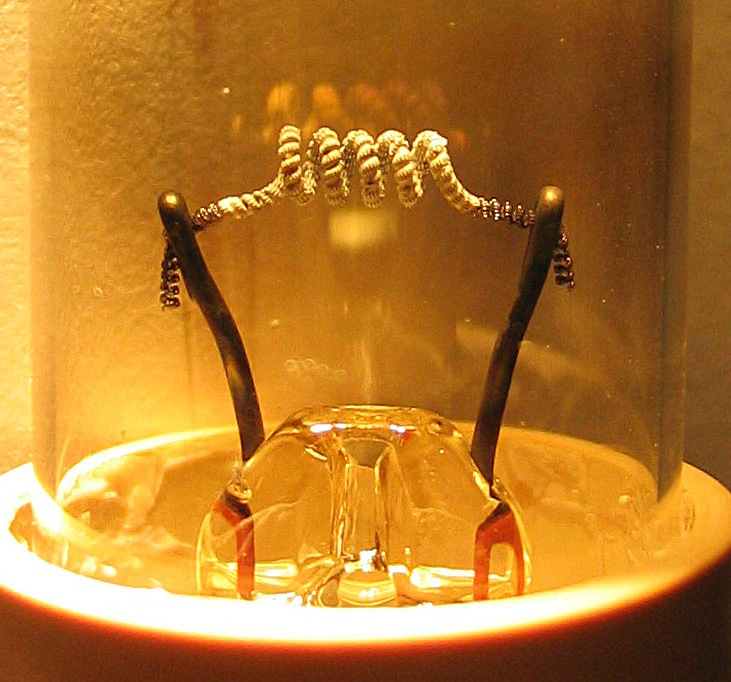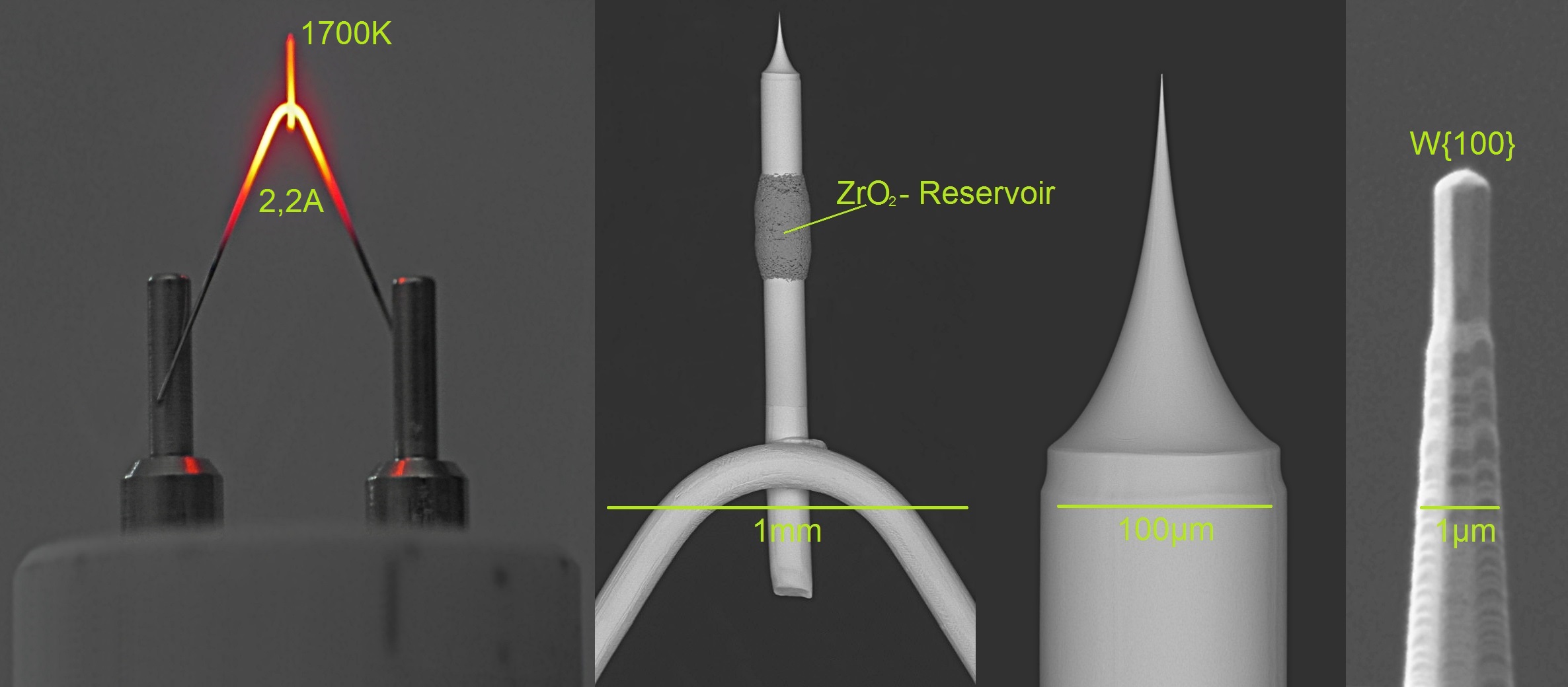|
Nottingham Effect
In condensed matter physics, the Nottingham effect is a surface cooling and heating mechanism that occurs during field and thermionic electron emission. The effect is named after physicist Wayne B. Nottingham who explained it in a commentary to 1940 experiments by Gertrude M. Fleming and Joseph E. Henderson. The temperature at which electron emission goes from heating to cooling is called the Nottingham inversion temperature. Description Notably, the effect can be either heating or cooling of the surface emitting the electrons, depending upon the energy at which they are supplied. Above the Nottingham inversion temperature, the emission energy exceeds the Fermi energy of the electron supply and the emitted electron carries more energy away from the surface than is returned by the supply of a replacement electron, and the net heat flux from the Nottingham effect switches from heating to cooling the cathode. Along with Joule heating Joule heating (also known as resistive heat ... [...More Info...] [...Related Items...] OR: [Wikipedia] [Google] [Baidu] |
Condensed Matter Physics
Condensed matter physics is the field of physics that deals with the macroscopic and microscopic physical properties of matter, especially the solid and liquid State of matter, phases, that arise from electromagnetic forces between atoms and electrons. More generally, the subject deals with condensed phases of matter: systems of many constituents with strong interactions among them. More exotic condensed phases include the superconductivity, superconducting phase exhibited by certain materials at extremely low cryogenic temperatures, the ferromagnetic and antiferromagnetic phases of Spin (physics), spins on crystal lattices of atoms, the Bose–Einstein condensates found in ultracold atomic systems, and liquid crystals. Condensed matter physicists seek to understand the behavior of these phases by experiments to measure various material properties, and by applying the physical laws of quantum mechanics, electromagnetism, statistical mechanics, and other theoretical physics, physic ... [...More Info...] [...Related Items...] OR: [Wikipedia] [Google] [Baidu] |
Thermionic Emission
Thermionic emission is the liberation of charged particles from a hot electrode whose thermal energy gives some particles enough kinetic energy to escape the material's surface. The particles, sometimes called ''thermions'' in early literature, are now known to be ions or electrons. Thermal electron emission specifically refers to emission of electrons and occurs when thermal energy overcomes the material's work function. After emission, an opposite charge of equal magnitude to the emitted charge is initially left behind in the emitting region. But if the emitter is connected to a battery, that remaining charge is neutralized by charge supplied by the battery as particles are emitted, so the emitter will have the same charge it had before emission. This facilitates additional emission to sustain an electric current. Thomas Edison in 1880 while inventing his light bulb noticed this current, so subsequent scientists referred to the current as the Edison effect, though it wasn't un ... [...More Info...] [...Related Items...] OR: [Wikipedia] [Google] [Baidu] |
Wayne B
Wayne may refer to: People with the given name and surname * Wayne (given name) * Wayne (surname) Geographical Places with name ''Wayne'' may take their name from a person with that surname; the most famous such person was Gen. "Mad" Anthony Wayne from the former Northwest Territory during the American revolutionary period. Places in Canada * Wayne, Alberta Places in the United States Cities, towns and unincorporated communities: * Wayne, Illinois * Wayne City, Illinois * Wayne, Indiana * Wayne, Kansas * Wayne, Maine * Wayne, Michigan * Wayne, Nebraska * Wayne, New Jersey * Wayne, New York * Wayne, Ohio * Wayne, Oklahoma * Wayne, Pennsylvania * Wayne, West Virginia * Wayne, Lafayette County, Wisconsin * Wayne, Washington County, Wisconsin ** Wayne (community), Wisconsin Other places: * Wayne County (other) * Wayne Township (other) * Waynesborough, Gen. Anthony Wayne's early homestead in Pennsylvania * Wayne National Forest in southeastern Ohio * ... [...More Info...] [...Related Items...] OR: [Wikipedia] [Google] [Baidu] |
Fermi Energy
The Fermi energy is a concept in quantum mechanics usually referring to the energy difference between the highest and lowest occupied single-particle states in a quantum system of non-interacting fermions at absolute zero temperature. In a Fermi gas, the lowest occupied state is taken to have zero kinetic energy, whereas in a metal, the lowest occupied state is typically taken to mean the bottom of the conduction band. The term "Fermi energy" is often used to refer to a different yet closely related concept, the Fermi ''level'' (also called electrochemical potential).The use of the term "Fermi energy" as synonymous with Fermi level (a.k.a. electrochemical potential) is widespread in semiconductor physics. For example:''Electronics (fundamentals And Applications)''by D. Chattopadhyay''Semiconductor Physics and Applications''by Balkanski and Wallis. There are a few key differences between the Fermi level and Fermi energy, at least as they are used in this article: * The Fermi ener ... [...More Info...] [...Related Items...] OR: [Wikipedia] [Google] [Baidu] |
Joule Heating
Joule heating (also known as resistive heating, resistance heating, or Ohmic heating) is the process by which the passage of an electric current through a conductor (material), conductor produces heat. Joule's first law (also just Joule's law), also known in countries of the former Soviet Union, USSR as the Joule–Lenz law, Assuming the element behaves as a perfect resistor and that the power is completely converted into heat, the formula can be re-written by substituting Ohm's law, V = I R , into the generalized power equation: P = IV = I^2R = V^2/R where ''R'' is the electrical resistance and conductance, resistance. Voltage can be increased in DC circuits by connecting batteries or solar panels in series. Alternating current When current varies, as it does in AC circuits, P(t) = U(t) I(t) where ''t'' is time and ''P'' is the instantaneous active power being converted from electrical energy to heat. Far more often, the ''average'' power is of more interest than the ... [...More Info...] [...Related Items...] OR: [Wikipedia] [Google] [Baidu] |
Field Emitter Array
A field emitter array (FEA) is a particular form of field electron emission, large-area field electron source. FEAs are prepared on a silicon substrate by lithographic techniques similar to those used in the fabrication of integrated circuits. Their structure consists of many individual, similar, small-field electron emitters, usually organized in a regular two-dimensional pattern. FEAs need to be distinguished from "film" or "mat" type large-area sources, where a thin film-like layer of material is deposited onto a substrate, using a uniform deposition process, in the hope or expectation that (as a result of statistical irregularities in the process) this film will contain a sufficiently large number of individual emission sites. Spindt arrays The original field emitter array was the ''Spindt array'', in which the individual field emitters are small sharp molybdenum cones. Each is deposited inside a cylindrical void in an oxide film, with a counterelectrode deposited on the t ... [...More Info...] [...Related Items...] OR: [Wikipedia] [Google] [Baidu] |
Fowler-Nordheim Equation
Field electron emission, also known as field-induced electron emission, field emission (FE) and electron field emission, is the emission of electrons from a material placed in an electrostatic field. The most common context is field emission from a solid surface into a vacuum. However, field emission can take place from solid or liquid surfaces, into a vacuum, a fluid (e.g. air), or any non-conducting or weakly conducting dielectric. The field-induced promotion of electrons from the valence to conduction band of semiconductors (the Zener effect) can also be regarded as a form of field emission. Field emission in pure metals occurs in high electric fields: the gradients are typically higher than 1 gigavolt per metre and strongly dependent upon the work function. While electron sources based on field emission have a number of applications, field emission is most commonly an undesirable primary source of vacuum breakdown and electrical discharge phenomena, which engineers work to ... [...More Info...] [...Related Items...] OR: [Wikipedia] [Google] [Baidu] |
Electrical Phenomena
This is a list of electrical phenomena. Electrical phenomena are a somewhat arbitrary division of electromagnetic phenomenon, electromagnetic phenomena. Some examples are: *Atmospheric electricity *Biefeld–Brown effect — Thought by the person who coined the name, Thomas Townsend Brown, to be an anti-gravity effect, it is generally attributed to electrohydrodynamics (EHD) or sometimes electro-fluid-dynamics, a counterpart to the well-known magneto-hydrodynamics. *Bioelectrogenesis — The generation of electricity by living organisms. *Capacitive coupling — Transfer of energy within an electrical network or between distant networks by means of displacement current. *Contact electrification — The phenomenon of electrification by contact. When two objects were touched together, sometimes the objects became spontaneously charged (οne negative charge, one positive charge). *Corona discharge, Corona effect — Build-up of charges in a high-voltage conductor (common i ... [...More Info...] [...Related Items...] OR: [Wikipedia] [Google] [Baidu] |


